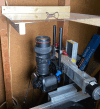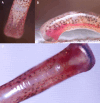Vascular and Osteological Morphology of Expanded Digit Tips Suggests Specialization in the Wandering Salamander (Aneides vagrans)
- PMID: 39780375
- PMCID: PMC11711880
- DOI: 10.1002/jmor.70026
Vascular and Osteological Morphology of Expanded Digit Tips Suggests Specialization in the Wandering Salamander (Aneides vagrans)
Abstract
For over a century researchers have marveled at the square-shaped toe tips of several species of climbing salamanders (genus Aneides), speculating about the function of large blood sinuses therein. Wandering salamanders (Aneides vagrans) have been reported to exhibit exquisite locomotor control while climbing, jumping, and gliding high (88 m) within the redwood canopy; however, a detailed investigation of their digital vascular system has yet to be conducted. Here, we describe the vascular and osteological structure of, and blood circulation through, the distal regions of the toes of A. vagrans using histology in tandem with live-animal videos. Specifically, we sectioned a toe of A. vagrans at 0.90 μm, embedded it in Spurrs resin, and stained the tissue with toluidine blue. An additional three toes were sectioned at 10 μm, embedded in paraffin, and after sectioning and mounting, treated with Verhoeff and Quad stains. For living salamanders, we recorded real-time videos of blood flowing within individual toes upon a translucent surface oriented both horizontally (0°) and vertically (90°) to simulate both prostrate and vertical clinging scenarios, then analyzed the image sequences using ImageJ. We found that the vascularized toe tips have one large sinus cavity that is divided more proximally into two chambers via a septum, and there are mucous and granular glands in the dorsal and dorsolateral integument of the digit tips. Live-animal trials revealed variable sinus-filling both within and between toes, seemingly associated with variable pressure applied to the substrate when standing, stepping, clinging, and climbing. We conclude that A. vagrans, and likely other climbing salamanders, can functionally fill, trap, and drain the blood in their vascularized toe tips to optimize attachment, detachment, and complex arboreal locomotion (e.g., landing after gliding flight). Such an adaptation could provide insights for bioinspired designs.
Keywords: arboreal; blood sinus; locomotion; mucous gland; toe.
© 2025 The Author(s). Journal of Morphology published by Wiley Periodicals LLC.
Conflict of interest statement
The authors declare no conflicts of interest.
Figures






Similar articles
-
Characterizing lift, drag, and pressure differences across wandering salamanders (Aneides vagrans) with computational fluid dynamics to investigate aerodynamics.J Morphol. 2023 May;284(5):e21583. doi: 10.1002/jmor.21583. J Morphol. 2023. PMID: 36976824
-
Aerial maneuvering by plethodontid salamanders spanning an arboreality gradient.J Exp Biol. 2022 Oct 15;225(20):jeb244598. doi: 10.1242/jeb.244598. Epub 2022 Oct 14. J Exp Biol. 2022. PMID: 36111422
-
Gliding and parachuting by arboreal salamanders.Curr Biol. 2022 May 23;32(10):R453-R454. doi: 10.1016/j.cub.2022.04.033. Curr Biol. 2022. PMID: 35609538
-
Organisation of the spinal central pattern generators for locomotion in the salamander: biology and modelling.Brain Res Rev. 2008 Jan;57(1):147-61. doi: 10.1016/j.brainresrev.2007.07.006. Epub 2007 Jul 27. Brain Res Rev. 2008. PMID: 17920689 Review.
-
Decoding the mechanisms of gait generation in salamanders by combining neurobiology, modeling and robotics.Biol Cybern. 2013 Oct;107(5):545-64. doi: 10.1007/s00422-012-0543-1. Epub 2013 Feb 22. Biol Cybern. 2013. PMID: 23430277 Review.
References
-
- Afferante, L. , Heepe L., Casdorff K., Gorb S., and Carbone G.. 2016. “A Theoretical Characterization of Curvature Controlled Adhesive Properties of Bio‐Inspired Membranes.” Biomimetics 1, no. 1: 3. 10.3390/biomimetics1010003. - DOI
-
- Aretz, J. , Brown C. E., and Deban S. M.. 2021. “Vertical Locomotion in the Arboreal Salamander Aneides Vagrans .” Zoology 316: 72–79. 10.1111/jzo.12934. - DOI
MeSH terms
Grants and funding
LinkOut - more resources
Full Text Sources

